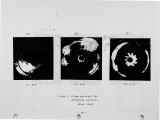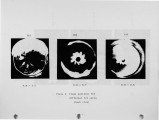| OCR Text |
Show a marked change. During E".R = 1.1 [Plate 3-(a) and 4-(a)] the reddish flames exhibits around the combustor wall and extended downstream to location X = 1.5 D. When E.R is decreased gradually to 0.7 [Plate 3-(b) and 4-(b)],the reddish flames disappears . And the blue flame with a little brushy reddish flame front emerges subsequently. More air is added (E.R= 0.6), the blue flames occupies whole reaction zone and extended downstream to X=1.5 D; seen in Plate 3-(c) and 4-( c ) • ~.MEASUREMENT RESULTS AND DISCUSSION The following section presents results which show the influence of air swirl on the flame characteristics. Detailed measurements of temperature and volume concentrations of four gas species including C02, CO, 02 and unburned He were obtained in the experiment. The results a~e presented as contour maps in which every map was usually made up at least 56 points. The contour maps of unbourned HC concentrations for three swirler flames are shown in Fig.2. The fuel of JP-5 provides the main part in HC concentrations. The result indicates that the high values of HC for S=0.3 flame are observed in the region of x/D<0.75. The HC values for 5=0.8 flame are concentrated in the near-wall region, but is much lower than that of low-s~irl flame. In case of S=I.2 flame, the result sho~s that there is no signicant He values in the region of x/D>0.25, which indicates the fuel burns almost completely before the region of x/D=0.25. It is evdient from the above results that the lower swirl causes a higher penetration of the fuel spray. This is mainly due to the low turbulent mixing rate associated with the low swirl. The temperature contour for 5=0.3 flame as seen in Fig. 3-(a) indicates that the maximum temperature (1250-1400 K) is recorded in the region, x/D=0.5-1.25 and r/R=0.35-0.85. For 5=0.8 and S=I.2 flames, the high temperature region shifts to upstream part of combustor and spreads wider and more uniform than that of 5=0.3 case. The high temperature enhances the evaporation of fuel spray and reduces the length of flames for high-swirl flames. From the result of Fig.4, the temperature at center line for S=0.3 flame is low before x/D=I.0 compared to other higher-swirl flames and suggests a hollow reaction zone for 5=0.3 case. - 5 - |























